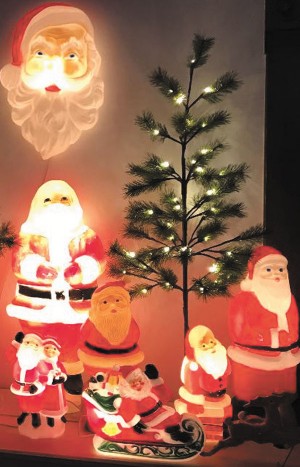Blow mold lawn ornaments have been with us since the 1940s, but they were not an instant hit. In an effort to increase sales and expand their lines, Union Products hired 1950s pop art icon Donald Featherstone in the spring of 1956. Throughout his career Featherstone would create over 750 plastic figures, but it would be his Pink Flamingos that would capture the hearts of the buying public and establish yard art as an American tradition.
With increased demand, the original process of mouth-blown figures was no longer practical and was replaced by compressed air blowing in 1957. That year would also see the original unlit two-dimensional figures converted to three dimensional figures that were lit with a small bulb.
Three basic materials have been used in the manufacturing of blow mold figures. Celluloid was most commonly used on the early pieces, followed by Vacucell and then fiberglass. The most common finds will be Vacucell which will be made in two pieces and held together with staples on the sides. There is some controversy over these pieces among serious collectors who do not consider them to be true blow molds, but they have held in popularity with mainstream buyers and collectors.
Two of the most highly sought after blow molds were manufactured by the L. A. Goodman Company in the early 1960s to be used as promotional giveaways by Polk Brothers Department Store of Chicago. Frosty the Snowman and Santa were both bulb lit, slightly over 5 feet tall and will be stamped with their name and “Copyright Polk Brothers, Chicago, Illinois.” Recent online pricing for Santa runs in the $300-$400 range and Frosty in the $450-$500 range.
Santas and snowmen, candles, carolers, elves, angels, full nativity scenes and reindeer are great finds. In addition to Union Products, other companies and their dates of production to watch for include: Artistic Latex Form Company 1940-1960, Beco Products 1950-1960, A.J. Renzi 1960-1970, Blinky 1960-1980, and Irwin Products 1960s.
In the 1980s companies began to outsourcing production and by the time we reached the 1990s most all blow mold was being imported from China. Collectors have little to no interest in these pieces.
Disney and other cartoon characters like Snoopy, while not “Christmas” figures, are fun to mix in when you display your collection. The older examples of these were made by “Santa’s Best” in the 1960s. There are also pumpkins and jack-o-lanterns from the late 1960s through the 1970s.
Due to the nature of their composition and exposure to the elements, damage and wear are quite common. To keep your molds safe, secure them with plastic bags filled with sand or gravel or when possible secure them to a fence, light post or a stake driven into the ground.
When purchasing vintage blow mold figures watch for frayed electrical cords, chipped paint and surface cracks. Condition is a major factor in determining value so be careful not to over-pay for a damaged piece. Until next time . . . Linda
Linda Kennett is a professional liquidation consultant specializing in down-sizing for seniors and the liquidation of estates.



